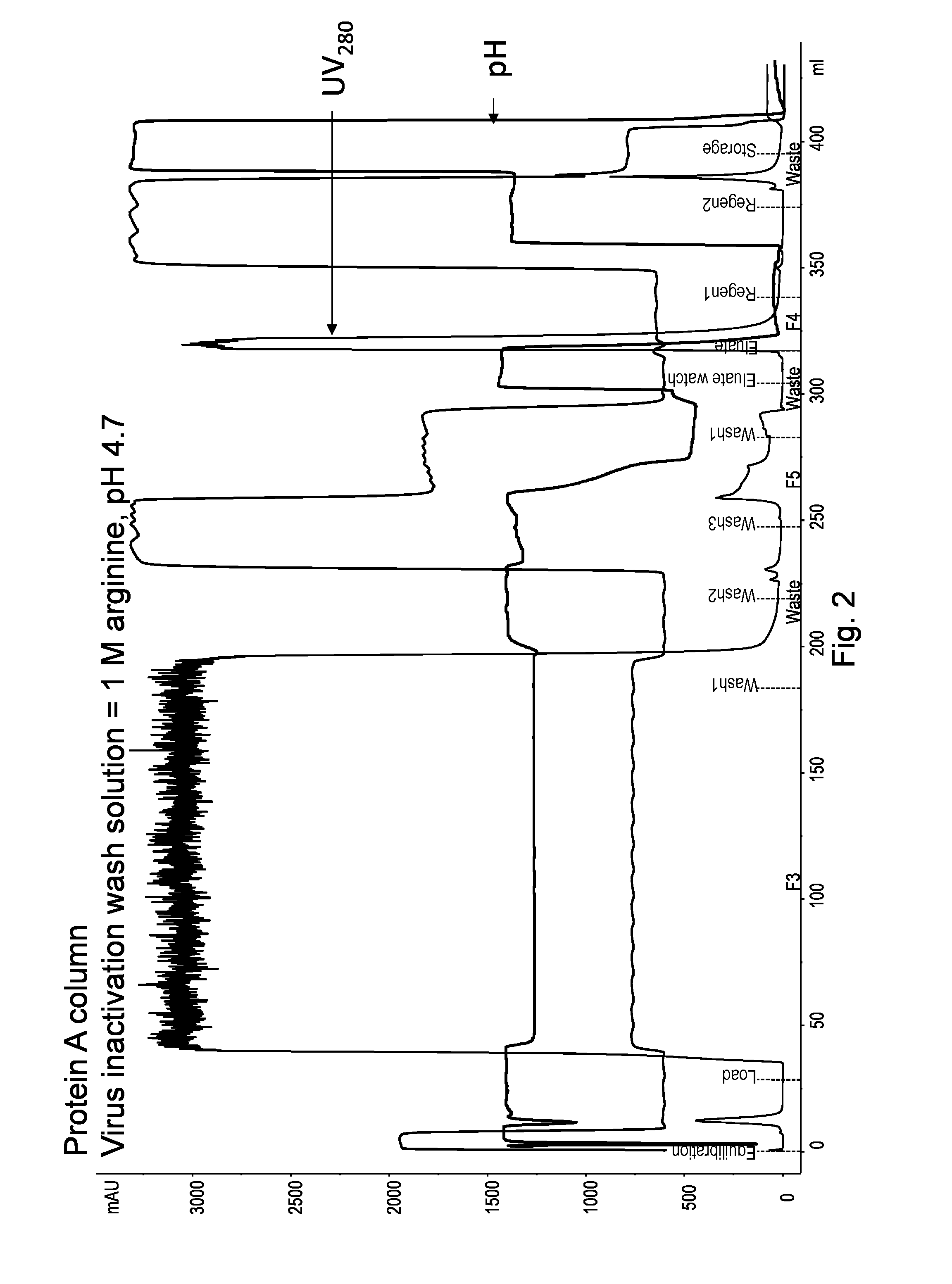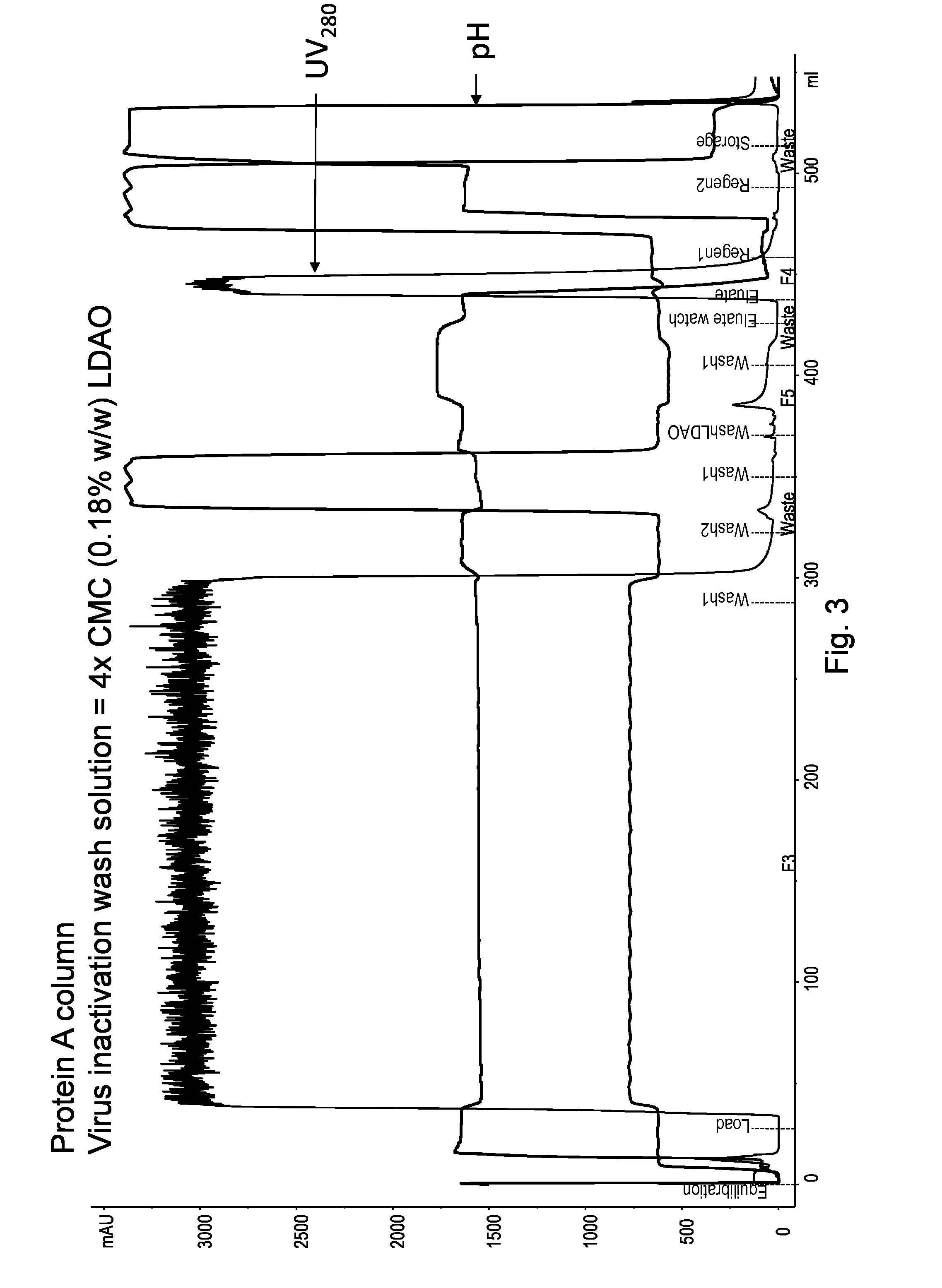On-Column Viral Inactivation Methods
- Summary
- Abstract
- Description
- Claims
- Application Information
AI Technical Summary
Benefits of technology
Problems solved by technology
Method used
Image
Examples
example 1
On-Column Viral Inactivation Using a Wash Solution Containing 2 M Ammonium Sulfate at pH 3.5
[0185]The objective of the experiments shown in Examples 1 to 10 is to demonstrate the feasibility and applicability of an on-column low-pH viral inactivation step using ProA and a target polypeptide. The polypeptide was bound to the ProA under standard conditions before a high salt at neutral pH was applied to the column. A subsequent wash at high salt and low pH was then applied to inactivate virus while the polypeptide remained bound to the adsorbent. A series of washes were, performed before the polypeptide was recovered using an elution solution.
[0186]The goal of the first experiment was to determine if on-column viral inactivation could be performed with minimal recovery loss using 2 M ammonium sulfate wash at, pH 3.5.
[0187]In this experiment, a 0.66 cm diameter MABSELECT™ SuRe column (7.2 mL; 21 cm) was first equilibrated (EQ) with 4 column volumes (CVs) of 10 mM sodium phosphate (NaPh...
example 2
On-Column Viral Inactivation Using a Wash Solution Containing 1 M Arginine HCl at pH 4.7
[0193]The goal of this experiment was to compare the effects of on-column viral inactivation using a wash solution containing 1 M arginine HCl at pH 4.7.
[0194]In this experiment, the Protein A column and the target polypeptide were the same as those in Example 1. A 7.0 mL (20.5 cm) MabSelect SuRe column was first equilibrated, and then 157 ml of HCCF containing Fc-fusion protein was loaded onto the column. Table 4 below summarizes the buffer solutions used in each step. The target polypeptide was bound to the Pro A under standard conditions. A subsequent modified wash 3 containing arginine was then applied to inactivate virus while the polypeptide remained bound to the adsorbent. The flow rate of the chromatography was consistent at 300 cm / hr or 1.7 ml / min except that a lower rate (100 cm / hr or 0.56 ml / min) was used during the arginine wash step (wash 3).
TABLE 4Individual buffers used in Example ...
example 3
On-Column Viral Inactivation Using a Wash Solution Containing 4×CMC Lauryldimethyl Amine Oxide (LDAO)
[0197]The goal of this experiment was to compare the effects of on-column viral inactivation using a wash solution containing 4× critical micelle concentration (CMC) lauryldimethyl amine oxide (LDAO).
[0198]In this experiment, the Protein A column and the target polypeptide were still the same as those in Example 1. A 7.0 mL (20.5) MABSELECT™ SuRe column was equilibrated and then loaded with 256 ml of HCCF containing Fe-fusion protein. Table 5 below summarizes the buffer solutions used in each step. The target polypeptide was bound to the Pro A under standard conditions. A subsequent modified wash 4 containing 4×CMC LDAO was then applied to inactivate virus while the polypeptide remained bound to the adsorbent. The flow rate of the chromatography was consistent at 300 cm / hr or 1.7 ml / min except that a lower rate (100 cm / hr or 0.56 ml / min) was used during the detergent wash step (wash ...
PUM
| Property | Measurement | Unit |
|---|---|---|
| Fraction | aaaaa | aaaaa |
| Fraction | aaaaa | aaaaa |
| Fraction | aaaaa | aaaaa |
Abstract
Description
Claims
Application Information
 Login to View More
Login to View More - R&D
- Intellectual Property
- Life Sciences
- Materials
- Tech Scout
- Unparalleled Data Quality
- Higher Quality Content
- 60% Fewer Hallucinations
Browse by: Latest US Patents, China's latest patents, Technical Efficacy Thesaurus, Application Domain, Technology Topic, Popular Technical Reports.
© 2025 PatSnap. All rights reserved.Legal|Privacy policy|Modern Slavery Act Transparency Statement|Sitemap|About US| Contact US: help@patsnap.com



